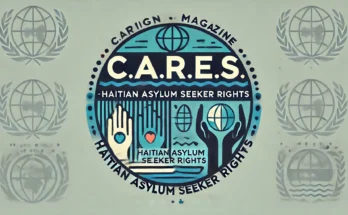C.A.R.E.S. Magazine International Migration Analysis
The Changing Face of Migration: A Global Analysis
Haitian International Migration Analysis, the movement of people across national borders, has been a defining characteristic of human history. Driven by a myriad of factors, including economic opportunity, political instability, and cultural exchange, migration has shaped societies, economies, and cultures worldwide. In recent decades, the dynamics of international migration have undergone significant transformations, influenced by globalization, technological advancements, and geopolitical shifts. This article will delve into the current state of international migration, examining its key trends, challenges, and opportunities.
C.A.R.E.S. Magazine Suggestions
Focus on Emerging Trends: Explore recent developments in international migration, such as the rise of refugee crises, the impact of climate change on migration patterns, and the increasing popularity of digital nomads. 2. Highlight Success Stories: Showcase individuals or communities that have successfully integrated into new societies, overcoming cultural barriers and economic challenges. 3. Address Ethical Considerations: Discuss the ethical implications of migration policies, including the treatment of migrants, the protection of human rights, and the prevention of exploitation. 4. Promote International Cooperation: Explore the role of international organizations like the United Nations, the International Organization for Migration (IOM), and regional bodies in addressing migration challenges and promoting cooperation.
FAQs – Haitian International Migration Analysis
Q: What are the most common reasons for international migration?
A: The most common reasons for migration include economic opportunities, political instability, conflict, natural disasters, and family reunification.
Q: What are the main types of international migration?
A: The main types of migration include labor migration, refugee migration, asylum-seeking, and irregular migration.
Q: What are the benefits of international migration for sending countries?
A: Benefits for sending countries include remittances, reduced unemployment, and the acquisition of new skills and knowledge.
Q: What are the challenges of international migration for receiving countries?
A: Challenges for receiving countries include social tensions, economic strain, and the integration of migrants into the host society.
Q. How can international organizations help manage migration flows?
A: International organizations can provide assistance with refugee resettlement, border management, and the protection of migrant rights. They can also promote cooperation between sending and receiving countries.
Pros and Cons of International Migration
Pros
- Economic Growth: Migration can contribute to economic growth by filling labor shortages, increasing innovation, and stimulating entrepreneurship.
- Cultural Diversity: Migration can enrich societies by introducing new cultures, traditions, and perspectives.
- Family Reunification: Migration allows families to reunite, strengthening social bonds and promoting emotional well-being.
Cons
- Social Tensions: Migration can lead to social tensions if not managed effectively, particularly in the context of economic competition and cultural differences.
- Exploitation: Migrants may be vulnerable to exploitation, including forced labor, human trafficking, and discrimination.
- Brain Drain: Sending countries may experience a “brain drain” as skilled workers migrate to other countries.
Analysis – Haitian International Migration Analysis
The landscape of international migration has evolved significantly in recent years, driven by a confluence of global trends. The displacement of millions of people due to conflicts, climate change, and economic hardship has resulted in unprecedented levels of migration. At the same time, advancements in technology and transportation have facilitated the movement of people across borders, making migration more accessible and affordable.
One of the most pressing challenges facing international migration today is the management of refugee crises. The influx of refugees from regions like Syria, Afghanistan, and Myanmar has strained the resources of host countries and exacerbated social tensions. While many countries have sought to provide humanitarian assistance, the long-term solutions to refugee crises remain elusive.
Another major issue is the exploitation of migrants, particularly irregular migrants who may be vulnerable to human trafficking, forced labor, and other forms of abuse. Addressing this problem requires a comprehensive approach that involves strengthening border controls, improving labor protections, and raising awareness about the risks associated with irregular migration.
The Role of Technology in Migration – Haitian International Migration Analysis
Technological advancements have had a profound impact on international migration, both in terms of facilitating movement and shaping the experiences of migrants. Social media platforms, communication apps, and online marketplaces have connected migrants with their families and communities back home, while digital remittances have made it easier for migrants to send money to their loved ones. However, technology has also created new vulnerabilities for migrants, such as online scams and digital surveillance.
The Impact of Climate Change on Migration – Haitian International Migration Analysis
Climate change is emerging as a major driver of migration, as rising sea levels, extreme weather events, and environmental degradation force people to leave their homes. The displacement of climate migrants poses a significant challenge for policymakers, as it requires coordinated efforts to address both the immediate needs of displaced populations and the underlying causes of climate change.
The Future of International Migration – Haitian International Migration Analysis
The future of international migration is likely to be shaped by a complex interplay of factors, including economic globalization, technological advancements, geopolitical shifts, and environmental changes. As the world continues to become more interconnected, the movement of people across borders is likely to increase. However, it is essential to ensure that this migration is managed in a way that respects the rights of migrants, promotes economic development, and fosters social cohesion.
Conclusion – Haitian International Migration Analysis
The dynamics of international migration are complex and multifaceted, and there is no single solution to the challenges it presents. To address these challenges effectively. It is essential to adopt a comprehensive approach. Those takes into account the diverse perspectives of migrants, governments, and international organizations. By promoting cooperation, understanding, and respect for human rights, we can create a more just and equitable world for all.
Written by Patrick Jacotin - Senior Editor



